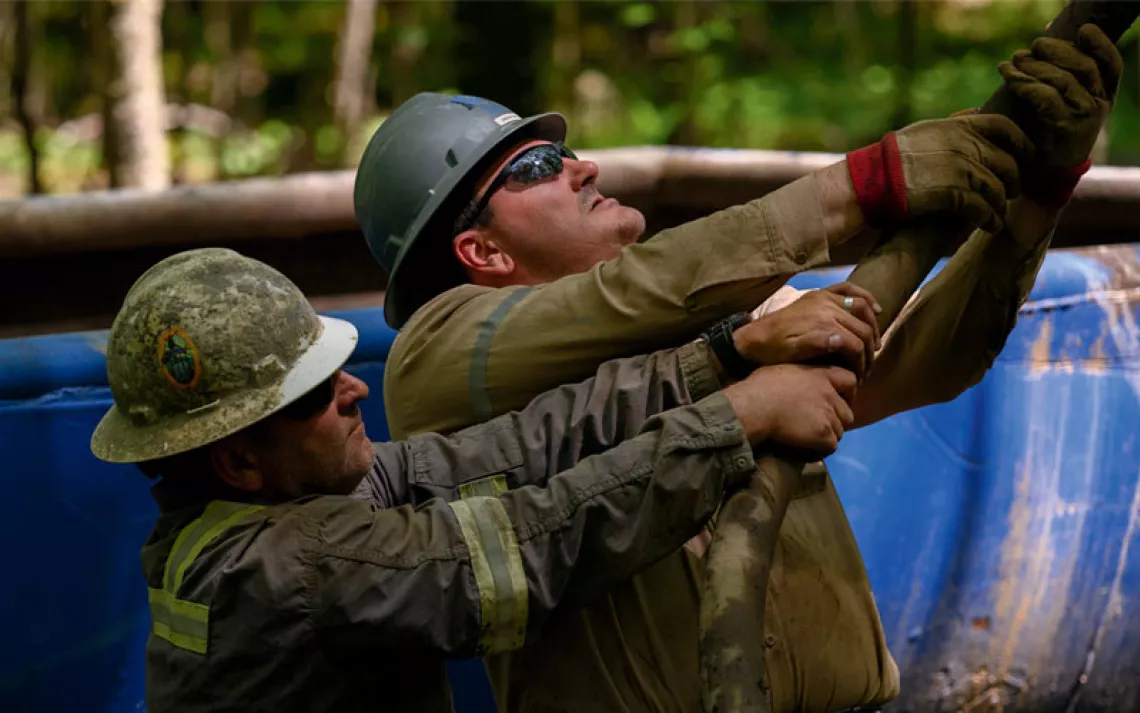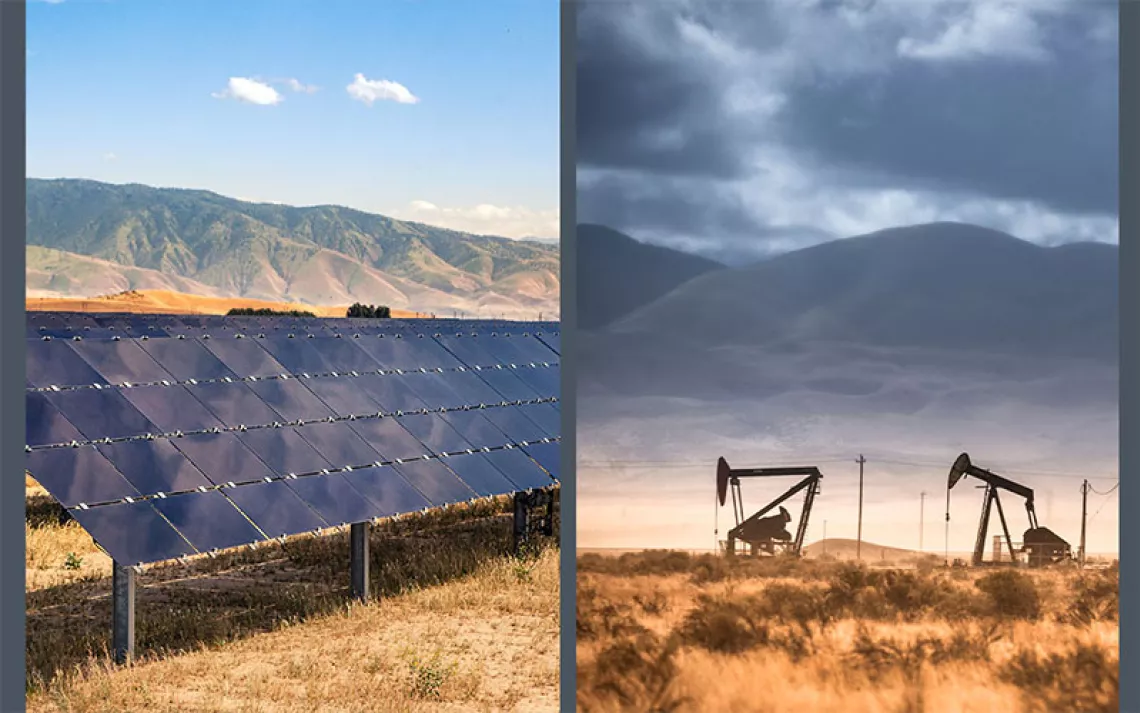Indigenous Peoples Want Canada to Start Listening
Why is the government going to such lengths for the Trans Mountain pipeline?

Photo courtesy of Greenpeace
Auntie Gloria’s clam fritters were legendary in the Tsleil-Waututh Nation territory of the Canadian province of British Columbia. Reuben George remembers them well. Back in 1953—the same year that the Trans Mountain pipeline was first put in use, carrying crude oil from Alberta to the coast British Columbia in Burnaby acrossfrom Tsleil-Waututh Nation territory—George would often walk out to the Burrard Inlet at low tide near his home to a bounty of oceanic delights, where people could simply pluck clams and other culinary treasures straight from the sea. Auntie Gloria’s fritters were in abundance back then.
That’s one of the memories that keeps him, his family, and other Coast Salish Nations motivated to continue their fight against the Trans Mountain pipeline. Tsleil-Waututh is one of several First Nations in Canada, along with the Squamish Nation and Coldwater Indian Band, that scored a resounding victory against Trans Mountain in the Federal Court of Appeal on August 30. The court found that the federal government’s review of the proposed expansion of the pipeline was fatally flawed.
In its decision, the court challenged the validity of the review on two points: the National Energy Board’s assessment process that led to its 2013 approval of the pipeline ignored the impact of increased oil tanker traffic in the Burrard Inlet as a result of the project, and, the Government of Canada failed to fulfill its legal duty to consult Indigenous peoples. As noted in a1,200-page assessment of the expansion plan conducted by The Sacred Trust, a Tsleil-Waututh Nation initiative, which found that the project is too risky, 87 percent of the traditional diet of the Tsleil-Waututh Nation comes from the water.
Following the announcement those long involved in the Indigenous-led resistance to the project— George, Grand Chief Stewart Phillip of the Union of British Columbia Indian Chiefs and Squamish Nation spokesperson Khelsilem—held a press conference during which it was noted that Indigenous Peoples in Canada would not waver in their commitment to protecting land and water resources and that they would continue the fight in the courts and on the land as long as it took.
“They (the government of Canada) did not behave honourably. The consultation was in effect note-taking and there was no meaningful addressing of our concerns,” said Khelsilem, a newly elected councillor and spokesperson for Squamish Nation, at a press conference following the Court’s decision. “So today, I stand before all of you with my people to tell Prime Minister Justin Trudeau that he must listen to the courts and must stop picking fights with Indigenous Peoples.”
Canada’s proposal for expanding the pipeline—formerly owned by Texas-based energy infrastructure company Kinder Morgan and recently purchased by the government—involves tripling its capacity to nearly 900,000 barrels per day by adding an additional pipeline. It would twin the existing Trans Mountain infrastructure and follow the same route snaking its way from the Alberta oil sands through the BC interior to an expanded marine terminal on the Burrard Inlet.
For the Tsleil-Waututh, also for the Squamish Nation and other Coast Salish peoples, the pipeline threatens the waters on which they rely. For them, the water really is life. It’s not a catchphrase, it’s law.
“Our first laws come from our story of creation. The first man was wolf, the first mother came from the Burrard Inlet in our waters,” George explains. “What does a mother do for you? She feeds you and takes care of you and makes sure you have abundant food. So what do we do for our mother? We protect her. That’s a reciprocal relationship of lineage and of spirit that we protect what we love. That’s our law.”
As George notes, it would have been simple to accept the economic benefits that come with the pipeline, such as the $13 million provided to First Nations through Kinder Morgan’s engagement program. But instead, his Nation, adhering to its own stewardship policy, decided to use some of their own resources to fight the proposal and work towards cleaning up the inlet and return the Tsleil-Waututh territory to what it once was.
“It was so abundant,” he says. “And we want our kids to experience that.”
In the early ’70s, increased pollution in the Burrard Inlet resulted in the closure of the shellfish harvest and decimated wild salmon stocks. Following numerous restoration projects,a clam harvest was held in the territory for the first time in three decades. The salmon count in the Indian River, which according to George was down to 6,000, was brought back to six million over the last 10 years. Elk was also successfully reintroduced, George says, which prompted the return of wolves and grizzly bear.
“We do this to protect our lands and water but it is also to help everybody,” George affirmed. “We don’t tag a salmon and say you can’t fish it. Those salmon are going to go out into the Pacific and people are going to benefit from the work we are doing.”
The Squamish Nation never relinquished their cultural and societal practices despite being faced with an extended period of what Khelsilem calls “cultural genocide” when Indigenous Peoples in Canada faced residential schools and the Sixties Scoop.
In Canadian history, Indigenous young people were taken from their homes and families and moved to government-sponsored religious schools designed to assimilate children to European culture. Although the schools were established in the late 19th century, the last residential school didn’t close until 1996.
In addition, an estimated 20,000 Indigenous children were also subject to forced adoptions, as they were literally “scooped” from their homes deemed unsuitable by the Canadian government and placed in foster care. The practice persisted for decades.
It was these practices and others that were documented in Canada’s Truth and Reconciliation Commission that led to calls for reconciliation and a greater role for the country’s First Nations in determining what is in their own best interests, including, for example, with regard to development projects that impact their traditional territories.
Members of Squamish Nation, Khelsilem says, made choices to adapt to modernity, and participate in the wage economy of their own free will, but there is a strong desire to repair the damage to their culture and repair what was lost. And as a Coast Salish people, much of that is connected to taking care of the water and the land.
“We’ve lost a lot but we are also choosing to regain it because we as a people, as a family, say this is important to us and this is who we want to be in the coming century,” Khelsilem explains.
There is much that the rest of Canada could learn from Indigenous Peoples in how they approach projects on their territories that impact land and water. For instance, Khelsilem cites the Seventh Generation Principle, which isa well-documented aboriginal concept that dates back hundreds of years to the writing of the Great Law of Iroquois Confederacy. It states that any decision over resources should be sustainable for seven generations into the future.
It’s something Khelsilem says was also part of the history of the Squamish Nation.
“We have words for our great great great great grandchildren, so we can actually talk about those people to come,” he says. “The word itself means from the land, so it is really imbedded in our language and you can see that. It’s part of who we are. These things are all connected for us, and we continue to maintain those practises and those beliefs.”
The Trans Mountain decision is just one in a long line of similar victories that reinforce the legal requirement to meaningfully consult with First Nations. Clarity on the issue was established at the Supreme Court of Canada in 2014 with Tsilhqot’in Nation vs. British Columbia, when it was found that the province needed to get consent from the Tsilhqot’in Nation before engaging in clear-cut logging.
A new study by the Stockholm Institute found that further expansion of Canada’s tar sands via Trans Mountain and Keystone XL pipelines would contribute to carbon lock-in and long-term oversupply of oil, slowing the world’s transition to a low-carbon future. Together with the Keystone XL pipeline, the potential expansion in greenhouse gas emissions would be equivalent to putting 32 million cars on the road.
Given the Canadian government’s commitments under the Paris Climate Agreement, and Trudeau’s election promise to adhere to the principles of the United Nations Declaration on the Rights of Indigenous Peoples, why is Canada going to such great lengths for a pipeline?
For decades, Alberta crude oil has sold at a discounted rate when compared to the best North American price, West Texas Intermediate. Getting bitumen to tidewater and more markets means a potentially higher price for the product. Canada wants a massive expansion of the Trans Mountain pipeline to feed potential overseas markets. With an election on the horizon in 2019, failure to do so would be a disaster for Prime Minister Trudeau, who has invested significant political capital in his pledge to take Trans Mountain across the finish line.
Although Trudeau has yet to announce next steps, there has been much talk of potentially challenging the decision at the Supreme Court of Canada. It seems unlikely the plan to expand Trans Mountain will be dropped.
That’s why people like Grand Chief Phillipvow to continue their resistance.
“This is not my first rodeo,” Phillip said. “I know this battle will continue, day by day, month by month, year by year, before we can finally stand back and say that British Columbia is off limits for toxic resource development projects that do not respect the land and the waters of B.C.”
If, or when, Canada restarts its review process for the pipeline’s expansion, the question remains whether it will properly consult First Nations at the beginning instead of at the end of the process. A recent study on Indigenous-led reviews by the consultancy Firelight Group is garnering significant interest in this regard.
The report, by the Gwich’in Council International (GCI), is based on case studies primarily in the Arctic where there were concerns over the Porcupine caribou herd and habitat fragmentation caused by resource development. But there is also one case in British Columbia that looks at the Squamish Nation.
It shows that Indigenous Peoples participating in decisions on major projects doesn’t have to be an afterthought, and can be of great benefit.
“As partners in comanagement we are upholding our inherent rights and responsibilities to take care of our people and our way of life,” says Jordan Peterson, Deputy Grand Chief of the Gwich’in Tribal Council and board member of the GCI. “This study shows that there are many options and tools now being developed that Indigenous nations can use to assess and making binding decisions on major projects.”
Khelsilem says Indigenous Peoples are open to certain projects, as long as they are the right projects, and as long as they involve First Nations participation in a meaningful way. For them, Trans Mountain is absolutely not an example of smart development.
“In the mosaic of Canada, there is a lot to be learned from Indigenous Peoples,” he says. “I think the insistence on this pipeline project really shows a lack of leadership for the future generations about the kind of country that Canada could be.”
 The Magazine of The Sierra Club
The Magazine of The Sierra Club



